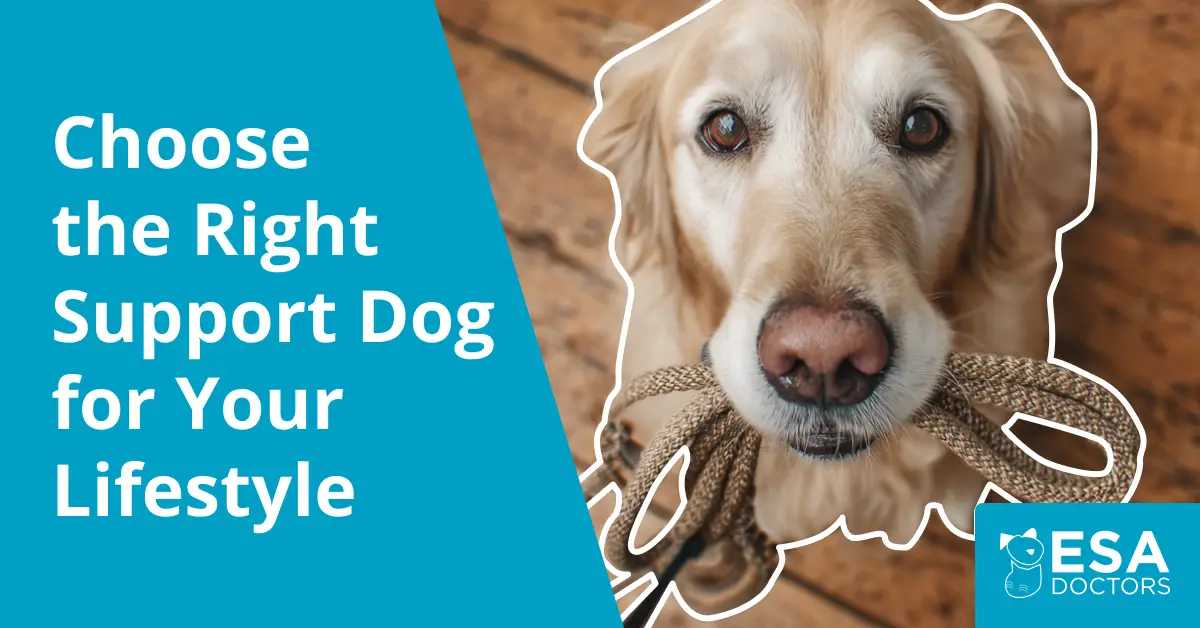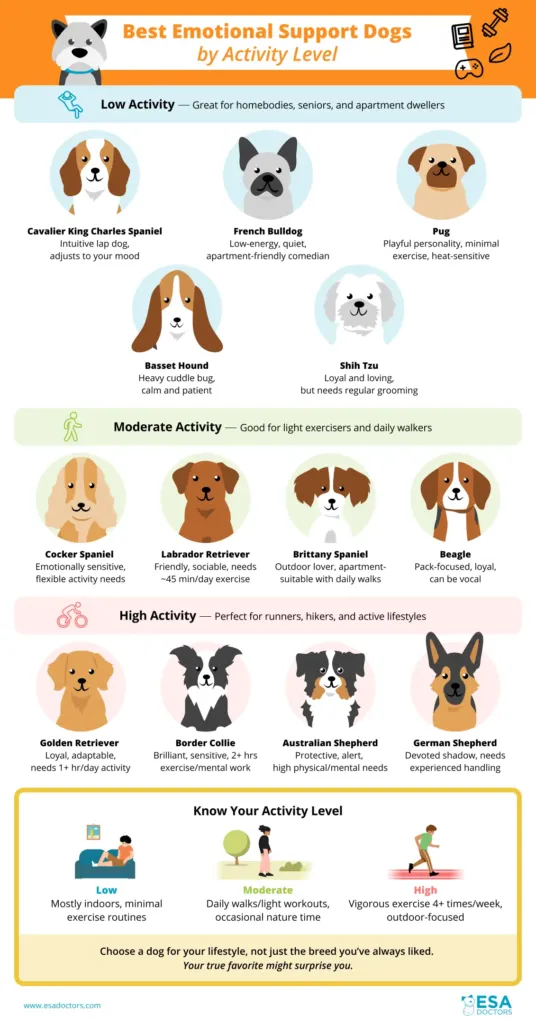Your emotional support dog should fit your actual daily routine, not the one you wish you had. Many people choose a dog based on what sounds good in theory, only to find themselves stressed when reality sets in. The right ESA for your activity level is one whose exercise and stimulation needs match what you can realistically provide on both good days and difficult ones.
When the pet’s needs align with your own lifestyle, you’re more likely to build a positive, low-stress relationship, which enhances the support your emotional support animal provides. This guide breaks down the best breed options for low, moderate, and high activity lifestyles, plus practical tips for honest self-assessment.
Why Activity Level Matters for Emotional Support Dogs
Making a great match between human and pet always matters, but you need extra consideration when your pet will also be your emotional support animal. Here are some reasons why choosing the right ESAl for your activity matters:
- A well-matched dog is more likely to thrive emotionally and physically, and as a result, offer consistent emotional support and companionship.
- Poorly matched dogs could develop behavior problems (excess barking, separation anxiety, destructive habits), which can add to your stress rather than relieve it.
- A good fit encourages daily routines, shared activities, and a stable bond — all of which contribute to you and your pet’s emotional well-being.
Although some high-energy breeds, such as Australian Shepherds, Border Collies, German Shepherd Dogs, and Labrador Retrievers, can make excellent emotional support animals, they require substantial amounts of exercise and mental stimulation. If you’re a homebody, have limited mobility, or work long hours away from home, a high-energy dog might become anxious, frustrated, and even destructive, which can undermine the emotional support they’re meant to provide.
If you lead a calmer lifestyle and like to hang out at home, low-energy breeds like the Cavalier King Charles Spaniel, Havanese, Maltese, Shih Tzu, Toy Poodle, and Yorkshire Terrier thrive on companionship more than constant activity, making them ideal lapdogs and emotional anchors.
Breeds such as the Beagle, Cocker Spaniel, Collie, and Soft-Coated Wheaten Terrier have moderate energy needs that are easily met with daily walks and playtime.
Best Emotional Support Dogs for Low Activity Individuals
“Low activity” can occur in various circumstances, whether you’re a stay-at-home type versus a going-out kind, a senior with mobility limitations, an apartment dweller with limited space, or a desk-bound worker with a busy schedule. If you are not big on exercise or outdoor activity, a low-energy emotional support dog will be a good match.
These are some breeds and mixes that do well in a less-active home:
Cavaliers were bred to be lap warmers for British royalty. They’re small enough (13-18 pounds) that they won’t overwhelm you, but big enough to feel substantial when they lean against you. They seem to read your mood and adjust their energy accordingly.
French Bulldogs are perfectly happy spending all day inside, maybe just a short walk around the block, and owners love their comedic antics. If you’re in an apartment, Frenchies are ideal. They don’t bark much, they don’t need a yard, and they’re not going to destroy your furniture if you don’t take them hiking every weekend.
Pugs are perfect if you want a dog with personality but live in a small space. They’re happy with a couple of short walks and some indoor playtime. Keep in mind that pugs can have breathing problems, especially in hot weather. If you live somewhere with brutal summers or you’re very active outdoors, they might struggle to keep up.
Basset Hounds are different from the small dogs; they’re about 40–60 pounds, which means when they lean against you, you really feel it. Some people find that comforting weight helpful during panic attacks. They’re also incredibly patient. We’ve never met a Basset Hound that seemed stressed about anything.
Shih Tzus are wonderful apartment dogs who form deep bonds with their people, but keep in mind they require a lot of grooming.
Best Emotional Support Dogs for Moderate Activity Individuals
People with moderate activity levels can live happily with any of the less-active dog breeds mentioned above, but you can also make a good match with an emotional support animal that’s a bit more active. Here are some examples:
Cocker Spaniels give you emotional sensitivity in a manageable size (20–30 pounds). They can sense when anxiety is building and will sit by your feet — present but not pushy. Their exercise needs are flexible; on some days, a block walk works, and on other days, they’re happy exploring longer trails.
Labrador Retrievers are friendly enough to help with social anxiety. Your Lab will want to greet neighbors on walks, giving you natural conversation starters when talking feels hard. They need more activity than some breeds, about 45 minutes daily. But they’re patient if you miss a day here and there.
Brittany Spaniels are smaller than Labs (30-40 pounds) but still encourage outdoor time. They were bred for hunting, so they love sniffing around on walks. They’re gentle enough for apartment living but happiest with a daily walk or short hike.
Beagles love sticking close because they were bred for pack work. Keep in mind they can be vocal. Some don’t mind their howling; others find it stressful in apartments.

Best Emotional Support Dogs for High Activity Individuals
High-energy dogs are a great match for runners who want a jogging partner, people who live in rural areas with ample room for dogs to explore, and outdoor recreation enthusiasts who enjoy hiking, cycling, and camping. High-activity individuals can also make a good match with many of the moderately active dog breeds mentioned above. Some high-energy breeds and mixes that also make great emotional support animals include:
Golden Retrievers are the most accommodating companions but need daily activity. They weigh 55–75 pounds and are built for work. They adapt to your energy while encouraging movement. When you’re ready for a walk, they’re thrilled. When you need time, they’ll wait patiently, but they need at least an hour of exercise daily.
Border Collies form intense bonds and learn your emotional patterns, but keep in mind they need two hours of real exercise daily plus mental stimulation. Without it, they’ll chew furniture or develop obsessive behaviors.
Australian Shepherds have a similar energy level with strong protective instincts. They’re naturally watchful, which helps if you struggle with feeling safe. They might patrol your apartment nightly. You’ll need to keep them both physically and mentally engaged to keep them from becoming destructive.
German Shepherds bond intensely with their owners. If you need constant loyal presence, they’ll become your shadow. With their strength and size (50–90 pounds), they need experienced handling. Without proper socialization, they can become overly protective.
Figuring Out How Active You Are
If you’re not sure whether your activity level is low, moderate, or high, think about your daily routine and preferences. Ask yourself questions, including:
- How often do I exercise, and what kind of exercise do I enjoy?
- Do I go on daily walks, hikes, or runs?
- Do I spend a lot of time indoors or outdoors?
- Am I frequently away from home, or do I spend a lot of time there?
Most people overestimate their activity level when choosing a dog, especially when they’re feeling motivated about making changes. But your ESA needs to fit your real life, not your aspirational one.
Low Activity
You prefer indoor activities and find exercise more draining than energizing. You might take occasional walks, but don’t have a regular exercise routine. You’re home most evenings and weekends, and your idea of outdoor time is sitting on a porch or balcony rather than hiking trails.
Moderate Activity
You genuinely enjoy daily walks or light exercise and feel good afterward. You might go to the gym a few times a week, take weekend nature walks, or have active hobbies, like gardening. You spend some time outdoors most days, but you’re not training for marathons or climbing mountains.
High Activity
Exercise is a regular, important part of your life that you rarely skip. You run, hike, bike, or do vigorous exercise at least four times a week. You often choose active weekend activities and feel restless when you can’t move your body. Physical activity genuinely improves your mood and mental health.
If you’re between categories, choose the lower one. It’s easier to give a moderate-energy dog more exercise than to manage a high-energy dog when you’re having a rough week.






Leave a Comment